If Windows Server Backup works perfectly fine, why invest in
another backup product? Good question. And a good answer is
client backup. If you need more than disaster
recovery for servers, Windows Storage Server 2008 R2 Essentials
(WSSE) is the ideal complement to SBS. WSSE includes a
client computer backup that is easy to configure and set up, and it
requires no intervention to keep all your SBS network’s client computers backed up.
Note:
WSSE is limited to 25 users and computers. However, you can
have multiple WSSE servers as members of your SBS network, so even
with a large SBS network you can ensure that all client computers
are backed up.
When you buy Windows Storage Server 2008 R2 Essentials, you buy
the hardware and software combined. You merely plug it in to your
network, turn it on, and configure it. We won’t cover the initial
configuration of your WSSE server here, because each Original Equipment
Manufacturer (OEM) will have a slightly different setup experience.
But when you have the WSSE server up and running, the experience will
be essentially similar, though each OEM might have special additional
applications and customizations for their solution.
1. Configuring Windows Storage Server 2008 R2 Essentials for an
SBS Network
Unlike Windows Home Server, WSSE can be a member server in an
SBS domain. This allows you to easily manage users and computers
assigned to a WSSE server, and also makes it easy to have multiple
WSSE servers on your network if you need to support more than 25
users and computers.
1.1. Connecting Windows Storage Server Essentials to the SBS
Domain
The first requirement for adding a WSSE server to your SBS
network, after you get it up and running, is to configure WSSE to
be a domain member. Before you can do this, however, you should
create a special security group of SBS users who are allowed to
connect to the WSSE server.
To configure your WSSE server to be a member of your SBS
domain, you first need to create a security group to control which
SBS users are allowed to connect to the WSSE server. To create the
security group for WSSE users and assign them an email address,
use the following steps:
Open the Windows Small Business Server Console, and
select the Users And Groups tab.
Click the Groups tab, and then click the Add A New Group
task to open the Add A New Group Wizard.
Click Next to open the Add A New Group page, shown in
Figure 1.
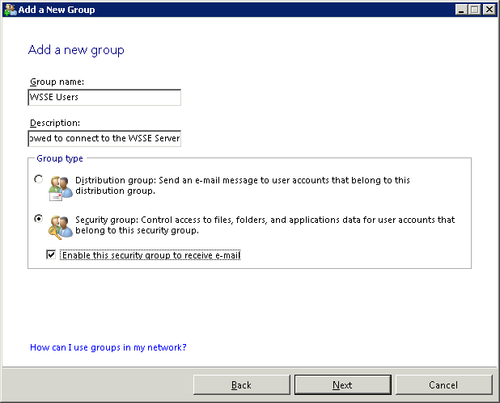
Enter a name for the group, and then select Security
Group. If you want to be able to send emails to this group of
users, select the Enable This Security Group To Receive E-Mail
check box.
Note:
E-mail enabling this security group allows you to send
maintenance downtime notifications and other information of
interest to the users of the WSSE server. But you should generally not
enable outside email for this group.
Click Next to open the Create A Group E-mail Address
page, as shown in Figure 2.

Click Next to open the Select Group Members For
WSSE Users page shown in Figure 3. (The
name on this page will be different if you’ve chosen a
different name for your security group.)

Select the users that you want to add to this group in
the left Users And Groups pane, and click Add to move them to
the Group Members pane.
Click Add Group to create the new security group, and
then Finish when the wizard is done.
After you’ve created the security group to control which
users have access to the WSSE server, you can join the server to the SBS
domain and begin connecting computers to the WSSE server for backup.
To join the WSSE server to the SBS domain, use the following
steps:
Open the Windows Storage Server 2008 R2 Dashboard shown
in Figure 4.
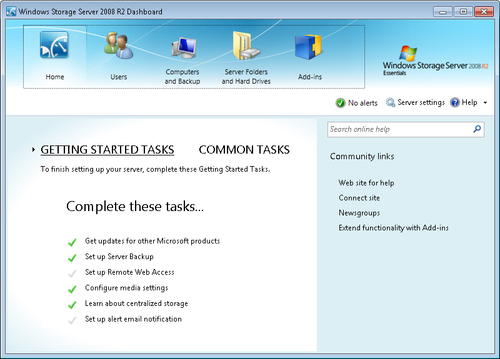
Click Server Settings to open the Server Settings dialog
box. Click Domain in the left pane, as shown in Figure 5, and
enter the name of the SBS domain in the Domain To Join
field.
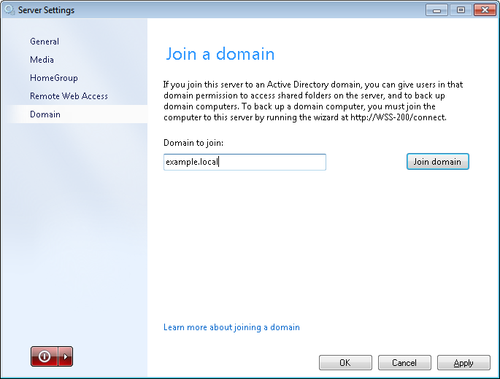
Click Join Domain, and enter the credentials for a
Network Administrator of the SBS domain.
Click OK and then click Yes on the Assign Access To
Domain Group dialog box, shown in Figure 6.

In the Select A Group dialog box, shown in Figure 7, select the
security group you just created and click OK.
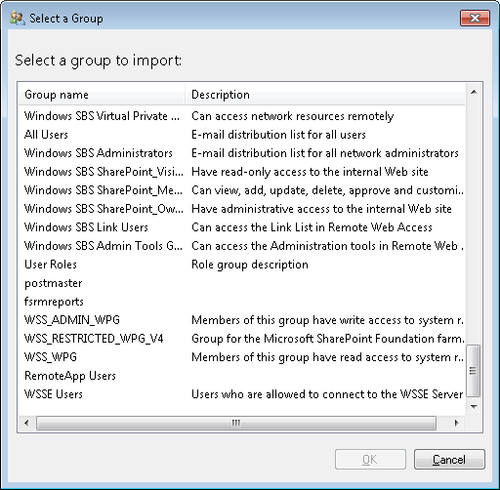
Click OK when prompted to reboot the WSSE server.
On the Windows SBS server, open Active Directory Users
And Computers from the Administrative Tools menu.
Navigate to the SBSComputers Organizational Unit (OU) as shown
in Figure 8.
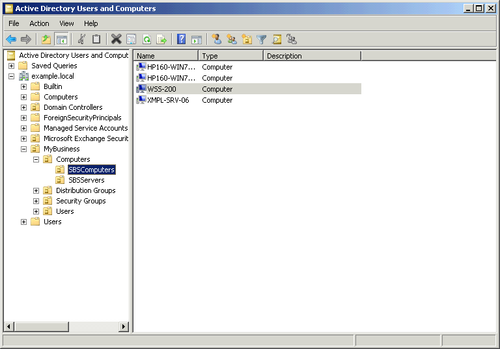
Select the WSSE server in the list of computers in the
SBSComputers OU. Drag the computer to the
SBSServers OU. You’ll be warned about moving objects in Active
Directory. Click Yes to confirm you want to do it.
Close Active Directory Users And Computers. Your Windows
Storage Server 2008 R2 Essentials server is now a member of
the SBS domain and ready for client computers to connect to it.